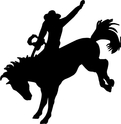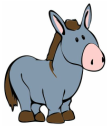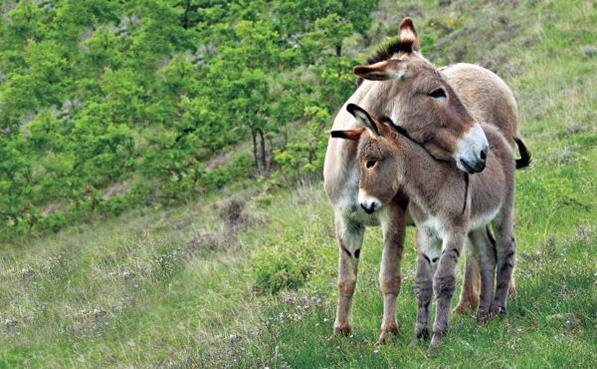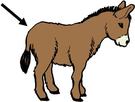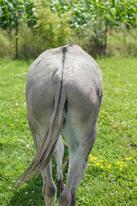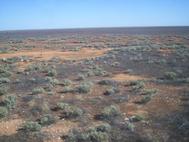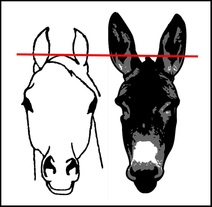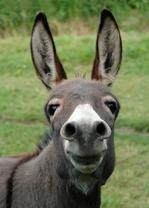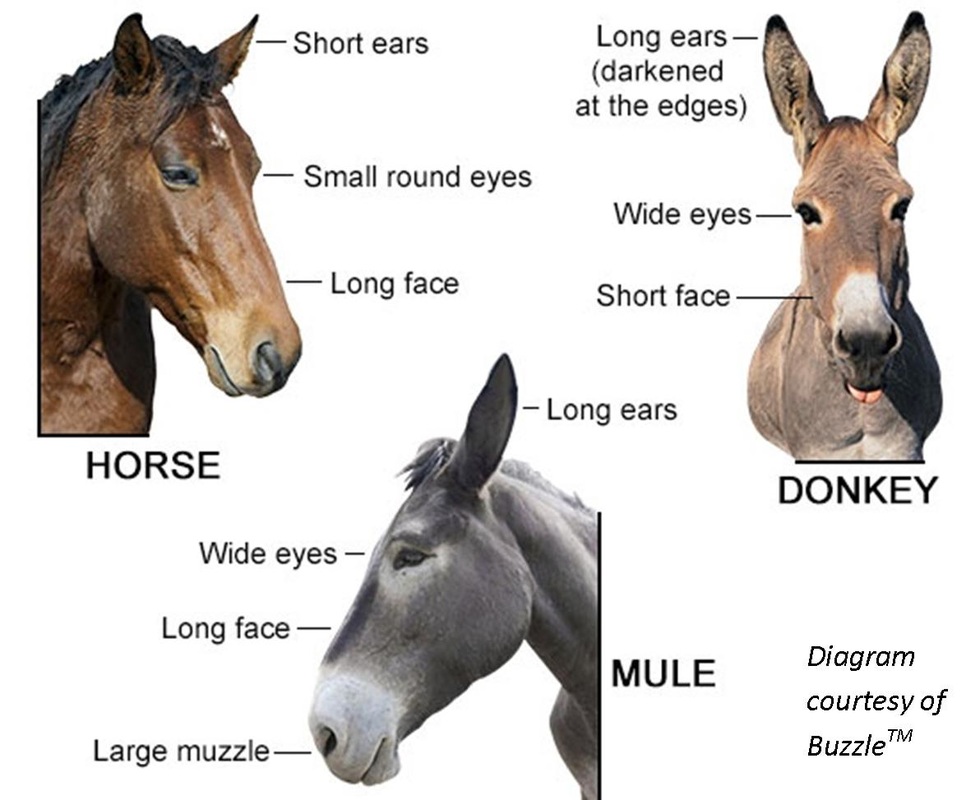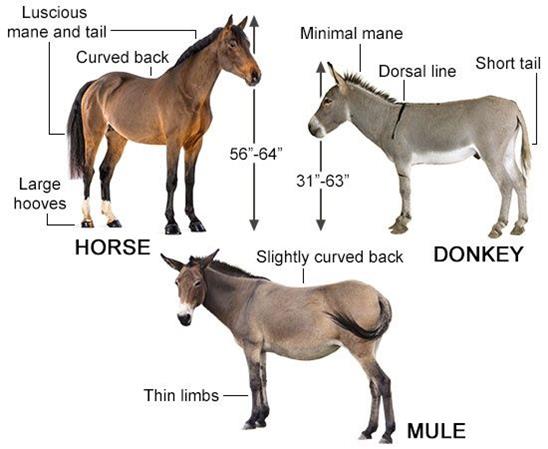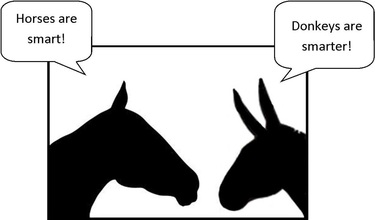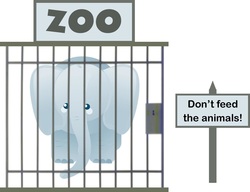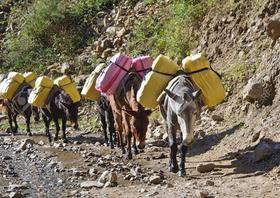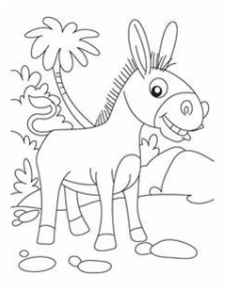L'IL BUCKAROOS
|
Hi! My name is Dan D. Donkey, and I'm glad to see you here. Can we just hang out together for a while?
See the donkeys over there? >>>>> That's my cousin Daisy, snuggling up to her mom. She's just a baby and my Aunt Dixie keeps a close watch on her. Daisy's cute, isn't she? I can't wait til she's all grown up so we can hang out together all the time. |
DONKEY SCIENCE
ALL IN THE FAMILY
|
Scientists use the term “family” to group together animals that share significant characteristics. Donkeys, burros and asses belong to the scientific horse family called Equidae. They do look like cousins, but there are plenty of differences between donkeys and horses. The difference between their ears is an easy way to tell who’s who. Donkeys’ ears are much longer than horses’ ears. That’s why donkeys are also called “long ears”.
|
DONKEYS versus HORSES = the same, but different?
Just like you and your brothers, sisters, parents, aunts, uncles and cousins, the members of the Equidae family are the same in some ways, and different in others. Let's compare them.
HOW THEY'RE BUILT, TOP TO BOTTOM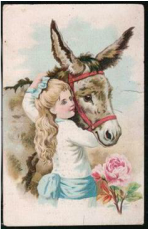
TEMPERAMENT
The donkey's emotions and relationships with other creatures (including human beings) are also unique. Donkeys can be used just like horses under saddle and in harness. They also make wonderful guard animals – taking care of entire herds of cattle, sheep or goats. They have a natural aversion to predators. That dislike will inspire the donkey to severely discourage any canine attacks on the herd. That nature goes along with donkeys' very strong inherent desire for self-preservation. They avoid putting themselves at risk or in harm’s way. Donkeys have lots of common sense, and coupled with their self-preservation, they've often been mistaken for centuries as stubbornness. That's probably where this saying came from: "As stubborn as a mule." When treated with patience, kindness and understanding, donkeys are willing partners for humans. If they're treated with force and abuse, they aren't likely to comply with your wishes. Donkeys don't forget how they have been treated and by whom. INTELLIGENCE Donkeys are more intelligent than horses; therefore, many times the training techniques for donkeys are different than those for horses. Their intelligence and their strong affinity for human interaction helps the training process along. |
The EARS of donkeys and horses aren't the only thing different between them. These diagrams help you see each characteristic (in case you don't have a donkey and/or a horse of your own to study).
NECK Donkey necks are straighter than horses. WITHERS Most donkeys don't have true withers BACK Without withers, the donkey's back is straighter where a horse's back curves. CROUP & RUMP This end of the donkey is a different shape because donkeys don't have the horse's double-curve muscle haunch. BONES Inside a donkey, the bones are dense and hard. That's one reason that makes donkeys well-suited to rocks and mountains, and they don't mind carrying heavy loads on their straight, sturdy backs. HOOVES Donkey hooves are narrow, oval and upright. They're also up-standing, made for rock and mountain climbing. They're tough, elastic and non-chipping. When a donkey lives on softer ground, the hooves grow very long without hard ground to keep them trim. VOICE Horses neigh, while donkeys bray. Donkey voices are raspy and brassy, with a characteristic "Aw-EE, Aw-EE" sound. MORE FACTS
Donkeys characteristically get by on less food than a horse of similar size, and need a lower protein content in their feed. Generally speaking, a mule or donkey can carry more weight than a horse because of their unique muscle structure. There are more than 40 million donkeys in the world, mostly in underdeveloped countries, where they are used principally as draught or pack animals. Working donkeys are often associated with people who live at or below subsistence levels - people who have just barely enough food, water, and shelter to survive. |
WHAT ABOUT BURROS?
|
The word “burro” comes from the Spanish word “borrico”, and it means “donkey.” Burros are small donkeys that are often used as pack animals, especially in countries that don’t have other ways to transport things from one place to another. The people load saddle bags onto a long parade of burrows like you see in this picture.
Because their hooves are upstanding and very tough, burros don’t mind walking for miles on a rocky dirt trail. Burros are cute, but they're also a very hard-working creature. They get by on little water. Just keep feeding them grass, treat them nicely, and they'll keep on working for you. |
|
Burros were first seen in the Arizona territory in 1679, when Jesuit priest Padre Eusebion Kino brought them to the Spanish mission at San Xavier de Bac, located in southern Arizona.
When gold was discovered at Gila City in 1858, prospectors poured into the area from California and Sonora, Mexico, bringing with them sturdy pack burros. In the hills and mountains of the lower Colorado River Valley, burros roamed free. They adapted well to the barren, nearly waterless hills and were indispensable to the prospectors' work. Serving as pack animals, they worked in the mines hauling ore, supplies, water and even machinery into desolate mining camps. The lone prospector and his trusty pack burro became a legendary symbol of the old west. In 2016, there are an estimated 11,700 wild burros free roaming in the United States. |
Arizona - 5,317
California - 3,391 Colorado - 0 Idaho - 0 Montana - 0 Nevada - 2,552 New Mexico - 0 Oregon - 56 Utah - 400 Wyoming - 0 TOTAL - 11,716! |
COLOR THE DONKEY |
DONKEY HUMOR |
